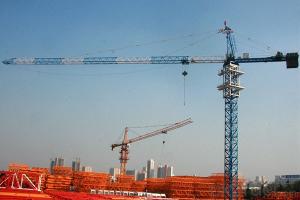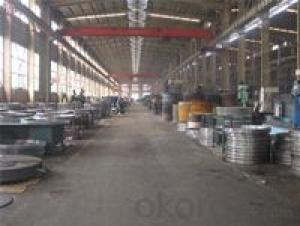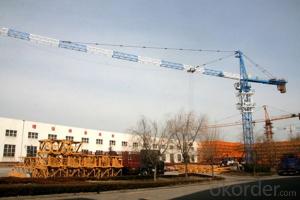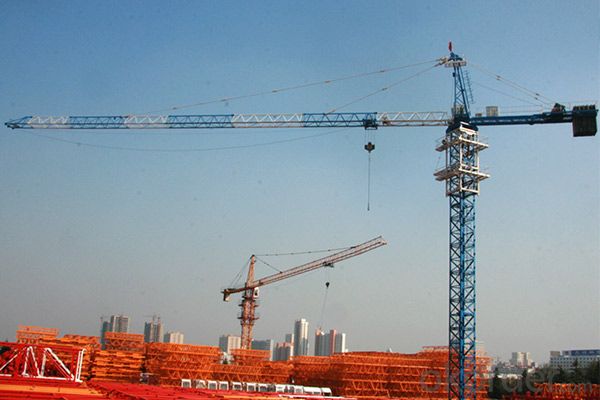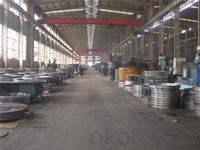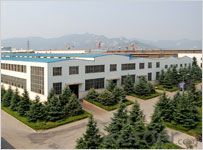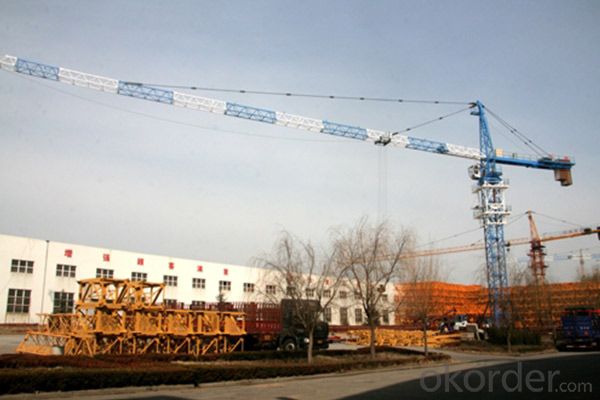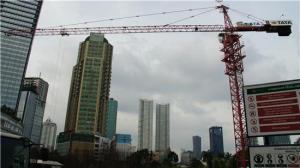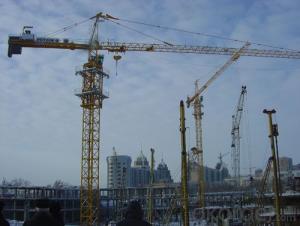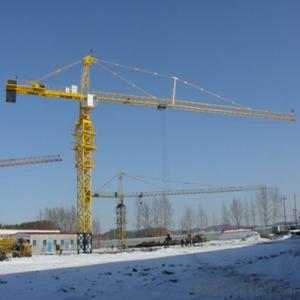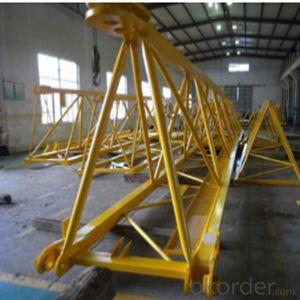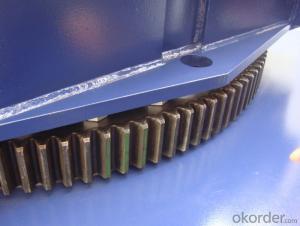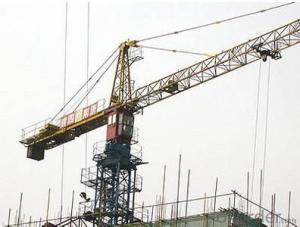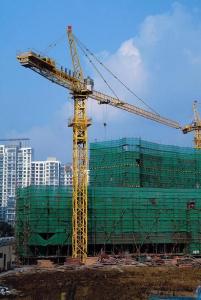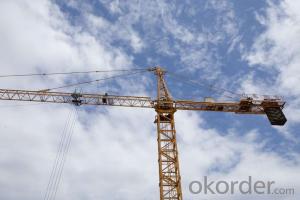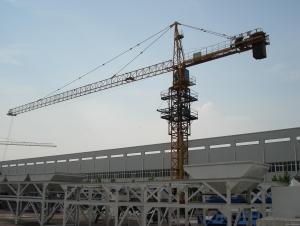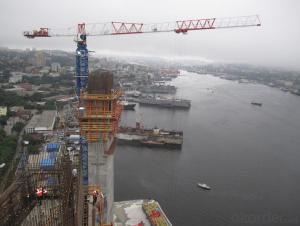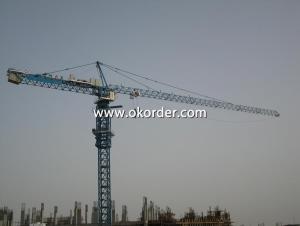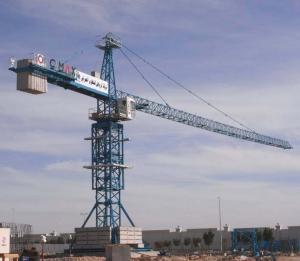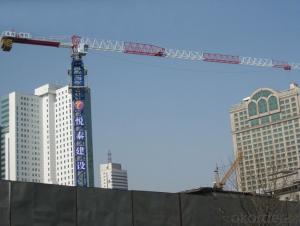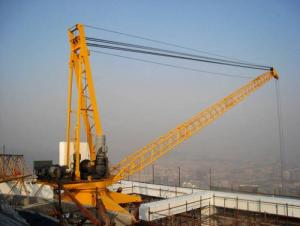TOWER CRANE QTZ63 TC5013 WITH top-rising mechanism
- Loading Port:
- Qingdao
- Payment Terms:
- TT or LC
- Min Order Qty:
- 1 unit
- Supply Capability:
- 1000 unit/month
OKorder Service Pledge
OKorder Financial Service
You Might Also Like
1、Survey
Thank you for choosing the product of Huaxia Group. Please read the Brief Introduction carefully to know the tower crane well.
The tower crane is a hydraulic tower crane with swing top, horizontal jib and mobile trolley. It has the hoisting moment for 760Kn.m;the maximum hoisting load of 6t and the maximum working radius of 50m.The hoisting height of anchoring tower crane is 40m and that of climbing tower crane is 140m.
The tower crane has ingenious design, beautiful shape and simple structure .It is easy to operate and maintain, and is safe and at a reasonable price .It is an ideal construction machines for construction enterprises. It has hoisting mechanism, swing mechanism, top-rising mechanism and radius mechanism, which can work individually or cooperatively to make a high efficiency. The top-rising mechanism is used to raise or lower tower. The hoisting mechanism has 3-speed electronic motor respectively for high, medium and slow hoisting speeds. It has flexible swing mechanism and radius mechanism and slewing mechanism for vertical and /or horizontal transportation of building materials in one time.
The tower crane has complete and sensitive protection devices such as hoisting weight limiter, hoisting moment limiter, hoisting height limiter, radius limiter and swing limiter to ensure of regular operation. It also has rest platform, guardrail and other protection devices. Driver’s cab is at a side of rib and has big space and wide visual field.
The tower crane has excellent performance and is suitable for hoisting in short civil or industrial buildings or loading or unloading in ports or goods yards
The products of Huaxia Group are your best choices of construction machines
Main Technical Parameters
Name | Unit | Parameters | |||||||
Nominal hoisting moment | kN.m | 760/870 | |||||||
Max. Hoisting weight | t | 6 | |||||||
Rated hoisting weight at jib nose | t | 1.3 | |||||||
Working radius | m | 2.5-50 | |||||||
Height (m) | Anchoring | M | 40 | ||||||
Climbing | m | 140 | |||||||
Hoisting speed | Magnification | 2X | 4X | ||||||
Hoisting speed | M/min | 8 | 40 | 80 | 4 | 20 | 40 | ||
Max. Hoisting weight | t | 3 | 3 | 1.5 | 6 | 6 | 3 | ||
Swing speed | R/min | 0.6 | |||||||
Radius changing speed | M/min | 22/44 | |||||||
Top rising speed | M/min | 0.5 | |||||||
Tower crane weight | Net weight (anchoring) | T | 31.4(32.9) | ||||||
Ballast weight | T | 12 | |||||||
Total weight (anchoring) | T | 43.4(44.9) | |||||||
Working swing radius | M | 51.254 | |||||||
Rear swing radius | M | 12.06 | |||||||
Maximum working wind speed | M/S | 20 | |||||||
Maximum wind speed for top rising | M/S | 13 | |||||||
Ambient temperature | ℃ | -20~+40 | |||||||
5、Technical Parameters of Main Parts
Name | Parameters | |||||||
Hoisting mechanism | Electric motor | Model | YZTD225M2-4/8/32 | |||||
Power | KW | 24/24/5.4 | ||||||
Rev | R/MIN | 1440/700/140 | ||||||
Reducer | Model | JD63A | ||||||
Reduction ratio | 10.35 | |||||||
Arrester | Model | YWZ-315/50 | ||||||
Braking moment | N.m | 630 | ||||||
Hydraulic propeller | YT1-50 | |||||||
Wire rope | 4V*39S+5FC-13-1770 | |||||||
Swing mechanism | Electric motor | Model | YZR132M1-6 | |||||
Power | KW | 2*2.2 | ||||||
Rev | R/min | 908 | ||||||
Reducer | Model | XX4-100 planetary reducer | ||||||
Reduction Ratio | 157.5 | |||||||
Brake | Normally open dry electromagnetic break | |||||||
Swing support | 011.40.1250 m=10 | |||||||
Radius changing mechanism | Electric motor | Model | YDEJ132S-8/4 | |||||
Power | KW | 2.2/3.3 | ||||||
Rev | R/min | 720/1440 | ||||||
Reducer | Model | BLD3.3-3 | ||||||
Reduction ratio | 43 | |||||||
Wire rope | 6*19-7.7-1570-I-Rightward twist | |||||||
Top rising mechanism | Electric motor | Model | Y132S-4 B5 | |||||
Power | KW | 5.5 | ||||||
Rev | R/min | 1440 | ||||||
Hydraulic Oil Cylinder | Model | HSGK-160/110 | ||||||
Piston course | mm | 1600 | ||||||
Working pressure | Mpa | 20 | ||||||
6、Form of Brief Introduction of Main Metal Structure
Name | Figure | Materials and Specifications | Remark | |
Mast | Standard Section | Main standard bar Tube Φ127×14 | Outline sizes:1600*1600 | |
Standard Section | Main standard bar ∠160×160×14 | Outline sizes: 1600*1600 | ||
Jib | Upper bar: Tube Φ89×8 | Total 8 Sections, | ||
Lower bar: Angle Steel | ||||
Cover Frame | Main bar: angle steel tube | It consists of welded angle steel, V-iron and armor plates. | ||
Upper And | Armor plates | It consists of welded armor plates in different sizes and shapes. | ||
Tower Top | Main bar: | It consists of welded angle steel, seamless steel and armor plates in trussed symmetric structure | ||
Balance Arm | V-iron | It consists of welded angle steel, V-iron and armor plates in space frame structure. | ||
Anchorage Support | It consists of H-shaped steel and armor plates. | |||

- Q: This is a new technology in ringging work. Hope anyone can give me some detail information about wireless crane scale.
- Hi, okorder for more information
- Q: The mobile crane has a weight of 116kip and center of gravity at G1; the boom has a weight of 29kip and center of gravity at G2. Determine the smallest angle of tilt θ of the boom, without causing the crane to overturn if the suspended load is W = 38kip . Neglect the thickness of the tracks at A and B. Determine the smallest angle of tilt θ of the boom, without causing the crane to overturn.
- The key here is to simplify this as much as possible The equation is really: mass 1 x length 1 + mass 2 x length 2 = mass 3 x length 3 G1 * 6 ft = (G2 * X ft) + H3 * X ft) G1 = 116 kip G2 = 29 kip H3 = 38 kip Now it is an equilibrium of torque about the point where the boom pivots: 116 kip * 6 ft = 29 kip * Xft + 38 kip * Xft solve for X feet: X feet = 10.388 ft So the crane is in equilibrium when the load is length1 + length 2 times the mass = mass of motor * length 3 (10.388 ft * 29 kip) + (10.388 ft * 38 kip) = 116 kip * 6 ft The boom forms a triangle with the hypotenuse equals 12ft + 15 ft = 27 ft. The bottom of the triangle is 10.388 ft + 10.388 ft = 20.776ft So we have two sides of the triangle and now just need to find the angle where the triangle forms with those two sides: cosine of angle = adjacent side / hypotenuse cosine of angle = 20.766 / 27 = 0.7691 and the arc cosine of that = 39.7 degrees So rounding it off, angle of crane = 40 degree
- Q: What is the difference between a tower crane and a jack up tower crane?
- The fixed tower crane means lifting the foundation of the tower body on the foundation or structure through the connecting piece.
- Q: What is an attached tower crane?
- Attached tower craneAttached tower crane is arranged close to the building, the tower by themselves to rise up with the increase of buildings and roof, tower, every 20m with attachment support device, the tower body is fixed on the building, in order to maintain stability. Figure 11 is a QT4 - 10 self - elevating four - tower crane (attachable, stationary, walkable, and climbing).
- Q: How much should the verticality of a tower crane be controlled? Thank you
- No, the wind speed is not more than 3m/s, the independent state tower (or attached state highest attachment point above the tower axis) lateral verticality tolerance is 4/1000, the highest tower axis perpendicularity allowed attachment line below the point of difference is 2/1000.
- Q: tnx for answering :)
- a japanese girl, gets cancer from the atom bombs that were dropped in hiroshima in the 50's. she is about 12 years old. apparently as a traditional story goes, if you make a thousand paper cranes then you can get one wish or something. i cant remember full story sorry but i do have the book. =) made me cry. xx
- Q: I am looking for guidance on determining the optimal design parameters for the design of an overhead travelling crane when considering a span of 60m and a lift requirement of 2500Tonnes. If not possible what would be the maximum lift for the same span
- is the 60 is the traveling distance or the span? if it is the span then this no way can be achieved or found, also 2500 tons is not logic for a single lift, you need to verify the design requirements. Usually crane span is related to structural frame spans, the lift has to be a practical one, which ranges from 1 ton to a 250 tons which is again very rare, majority traveling cranes are from 1 ton to 25 tons
- Q: any kind of sayings
- Whoop!
- Q: What is the fundamental differences between Goju-ryu Karate and Fujian White Crane?
- Actually the fundamental difference between all styles of Karate and all styles of kung fu is that Karate emphasizes linear striking techniques and kung fu emphasizes circular striking techniques. All Japanese influenced 'atemi' (striking) styles are linear. That is one way to identify the lineage of an Asian martial art, if the punches and kicks are thrown straight.
- Q: im 35 and in august i get my license back and i am going after my childhood dream of being a crane operator and was wondering how i need to go about achieving this?
- I am sorry I do not know where are you from as different country might have different requirement on getting a Crane Operator licence. Anyway, I believe the basic is the same: You need to attend a theory class on crane operations which usually include topics like design theory of cranes, slinging and lifting, signalling. After this, there will be a practical session to test your understanding and practical operations on an actual crane in the training center's facility. Good Luck and May You Attain You Dream :)
Send your message to us
TOWER CRANE QTZ63 TC5013 WITH top-rising mechanism
- Loading Port:
- Qingdao
- Payment Terms:
- TT or LC
- Min Order Qty:
- 1 unit
- Supply Capability:
- 1000 unit/month
OKorder Service Pledge
OKorder Financial Service
Similar products
Hot products
Hot Searches
Related keywords
